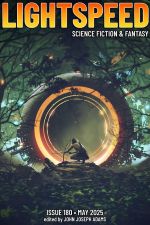“Rthing It Up: An Oral History” by Gene Doucette
“Shadows on the Pavement” by R. P. Sand
“The Temporal Displacement of the Graves” by Russell Nichols
“The Price of Manners” by Martin Cahill
“Through the Machine” by P. A. Cornell
“Where Are They Now?” by Meg Elison
“Ninnagan Says Remember” by Jonathan Olfert
“The Meaning We Seek” by Nancy Kress
Reviewed by Victoria Silverwolf
“Rthing It Up: An Oral History” by Gene Doucette consists of interviews with aliens about the disastrous failure of their attempt to assimilate Earth into a confederation of planets. The extraterrestrials are dismayed by human prejudice and self-destruction, while thinking of themselves as benign despite demonstrating all the crimes of colonialism.
Although the story deals with some serious themes, the mood is that of comedy. (The constant spelling of Earth as Rth demonstrates this tongue-in-cheek tone. The fact that the only physical difference between humans and aliens is that Earth people have no tails is further evidence.) Its jaundiced view of universal foolishness provides amusement. At nearly novelette length, the story’s unfailingly satiric point of view may wear out its welcome for some readers.
“Shadows on the Pavement” by R. P. Sand appears to be a message from the spirit of Earth to all of humanity, addressed as if they were a single individual. This brief work creates an appealing poetic mood, but its precise meaning is vague.
In “The Temporal Displacement of the Graves” by Russell Nichols, a married couple makes use of time travel to separately escape their lives in a flooded future world. As in most works featuring time travel, things don’t go exactly as planned, but the results are not very serious.
This very short story features a time machine that is treated as if it were an ordinary household device, making it difficult to suspend one’s belief. Time travel changes little, if anything, in the couple’s lives, so the work is best appreciated as a character study.
“The Price of Manners” by Martin Cahill features an enchanted book that can supply the user with whatever knowledge is desired, but at the cost of the user’s life. Only after a very long time does someone figure out what the book wants, and how it can be used safely.
Although the text provides a detailed history of the book and its doomed users, the lesson of this fable is a simple one. The revelation of the book’s secret is pleasant enough, but anticlimactic.
“Through the Machine” by P. A. Cornell takes place at a time in the near future when the images of movie stars are used to produce films through artificial intelligence, without the actors actually taking part in the process. The main character is one such celebrity, who spends his time making personal appearances rather than acting. Dissatisfied with this system, he seeks a way to make his profession meaningful.
The speculative technology is highly plausible, barely beyond what is possible today. The theme of AI threatening to remove creativity from human endeavors is an important one, and the author powerfully conveys it through the eyes of the protagonist. The conclusion offers a touch of hope without being overly optimistic.
Without naming the book or its characters, “Where Are They Now?” by Meg Elison is clearly based on the children that appear in Charlie and the Chocolate Factory by Roald Dahl. One of the youngsters who toured the strange candy factory tells the reader what really happened.
This brief story is notable mostly for its cynical look at a children’s classic. How readers respond to its dark ending will depend on what they think about the original book.
In “Ninnagan Says Remember” by Jonathan Olfert, a man who collects tithes for an oppressive religion allows a woman to cheat the system. As a result, he is severely punished and she is sentenced to death. His attempt to rescue her leads to a violent battle.
I have deliberately avoided mentioning the story’s fantasy content, which is not very relevant to the plot. The setting is a world where the reigning faith has replaced an older religion that worshipped gigantic trees. The story has the feeling of a bloody sword-and-sorcery yarn, although there is little or no magic present. At times, it qualifies as grimdark. Readers seeking plenty of action rather than supernatural premises will best appreciate it.
“The Meaning We Seek” by Nancy Kress features an artificial intelligence offering false, pleasant memories and removing pain from an elderly, dying woman. In exchange, she provides it with the opportunity to experience her sensations, for a reason the AI has not revealed to her.
In just over one thousand words, the author creates a complex background and a pair of memorable characters. The story also raises profound philosophical questions about human existence, without attempting to answer them in a facile manner. The result is a work that is sure to stay in the reader’s memory for a long time.
Victoria Silverwolf has read Charlie and the Chocolate Factory and seen both of its cinematic incarnations.
 Lightspeed #180, May 2025
Lightspeed #180, May 2025